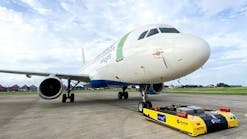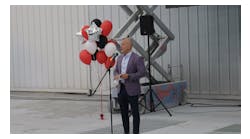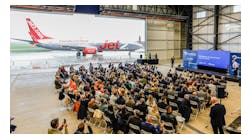Some have called airlines a customer service industry that flies aircraft. Airline customer service has been in the news lately. It has not been good news. Customer service goes far beyond the ticket counter, the boarding process, or the baggage claim. The customer seldom sees, or wants to see, the aviation maintenance technician; however, the role of the maintainer is key for keeping customers happy. What steps can maintainers and their organizations do to ensure customer satisfaction?
Varying Customer Service Expectations
Succinctly, customer service is the support provided by a company to users of their products or services. It also extends to potential users of the service, like buyers of an aircraft major maintenance service or avionics package installation. They want to be sure that sales will be supported during installation or when unexpected maintenance arises. For an airline ticket buyer, unless cheapest is the only driver, they want a company with a reputation for good customer service. Of course, even the lowest paying customer should have appropriate treatment.
In general aviation, an FBO that supports high-end business jets will have different customer comfort amenities than a small operator that sells fuel to small single-engine recip aircraft. That’s the customer expectation. It is relatively easy to deliver on the high-end expectation by building a nice lounge, keeping it open and clean, and providing the transportation and communication services that a jet customer would expect. That kind of treatment is obvious customer service. It is also nice to extend that same customer service to all customers.
In every aspect of aviation, the most critical product/service is safety. Safety is intangible. It is assumed by the customer. People don’t shop for varying levels of safety. This industry accepts a fiduciary responsibility, meaning that the aviation product/service provider has the highest degree of trust and obligation to ensure safety for the passenger. “Safe enough” is not an option. It is that simple.
The Role of Maintenance in Customer Service
While safety is assumed, we in the industry know that it's a goal that consumes much of our work. The job of the maintenance organization is to ensure that the aircraft are at the gate and ready/safe to depart on time. That must be done effectively and efficiently. Effectively means that it is right and safe. Efficiently implies that it is on time and as cost effective as possible. Both drive customer service/satisfaction.
When maintenance “gets it right” everyone is happy. From dispatch to gate, to flight and cabin crew, the flight launch is best when the aircraft is ready to leave on time and complete the route as scheduled. That is the kind of service that satisfies customers. Again, what specific actions should the AMT and maintenance organization take?
This author now puts on the human factors and regulatory hat to answer the maintenance customer service question. Based on analysis of maintenance delays and associated challenges Figure 1 offers a list of maintenance topics that can contribute to high customer satisfaction. The AMT cannot complete this checklist without management support. Thus, this list also applies to maintenance management.
Fitness for Duty
Maintenance workers must be physically fit and mentally awake to perform their job. Inadequate sleep is the primary fitness for hazard. When you're tired you do not think clearly. Your decision-making is diminished, as well as your communication skills. You're also susceptible to forgetting. Any one of these, or a combination, can lead to an error. Come to work rested!
Perhaps you're tired from too much overtime or too many days without a 24-hour break. Beware of excessive overtime. If overtime is a corporate norm then it puts a question to the company commitment to safe flight and satisfied customers. Speak up, continuous overtime must be controlled. Tired workers become injured workers. Can you really afford to lose work due to a personal injury?
FAA Advisory Circular 120-115 provides extensive guidance on fatigue risk management in maintenance (see AMT, December 2016). Come to work fit for duty.
Communication
Many negative events result from poor communication at shift change or when one worker completes a job that someone else started. The result is rework and/or flight delays. Talk to one another while recognizing that clear, correct, and complete communications will help ensure customer satisfaction. It is best to have written communications to help ensure that things “don't fall through the cracks.” Clear communication and documentation leave nothing to chance.
Follow the Technical Instructions
“Failing to Follow Procedures” is the No. 1 challenge in maintenance work. Management must support a culture of using the job cards and other procedural information. Following procedures must become as automatic as wearing a seatbelt when driving. Everyone must do it, without exception.
Colleagues must question others when they see them working without documentation. If we are serious about safety, injury, and satisfied/safe customers then we must shift our individual and corporate culture to 100 percent compliance with technical publications.
Everyone must cooperate to identify and correct difficult documentation. If it’s broke then get it fixed. Also, sometimes you remove wires or other parts to get access. Document all such removals to increase the likelihood of proper reassembly.
When someone does not use documentation ask “Why”. Then, ask “Why” enough times to identify the multitude of factors that lead to the failure to use documentation. Finally, find ways to fix the issues. That is the only way to address this issue.
Voluntary Reporting Systems
When something goes wrong avoid the practice of fixing the problem and moving on. When a professional sports team has repeated an error they find the problem and find a solution. Sometime the sports team fires the manager. It is important that aviation maintenance technicians report organizational hazards as well as errors that they may have made. Of course, there must be a fair/just system that permits one to report without serious repercussions. A maintenance error can lead to an event where one or more customers are not satisfied. Failure to find and correct the underlaying cause(s) of an error is another, more serious error. In fact, a decision not to investigate and correct an error is an intentional action! Revisit the term “fiduciary responsibility.”
Peer-to-Peer Assessment
Peer-to-peer assessment permits mechanics to “look at” and “look out” for one another. The practice is named Line Operations Safety Assessment (LOSA) (See www.humanfactorsinfo.com). The website provides process information and checklists to set up ways for formalized peer-to-peer observations during normal working conditions. These programs have helped some organizations to enhance the safety culture. Of course, an enhanced safety culture is a plus to ensure the best customer service.
Continuing Process Improvement
High customer service is not a steady state. You don’t merely reach it and then stop. It must be on the way up or it is on the way down. The maintenance organization must strive for ways to improve every process, if only a little. Small positive changes continue to add to customer service. Like the cultural change described in “Follow the Technical Instructions,” organizations must keep looking for ways to improve. A suggestion for improvement should never be considered in a negative light. Workers usually know more about the organizational changes than the managers know. Capitalize on worker information and input.
Convey Competence and Professionalism
Maintenance personnel know that they are surrounded by competent professional colleagues. They would let their spouses, mothers, and entire family fly on aircraft serviced by their colleagues. Workers trust their co-workers for all the demonstrated right reasons. Now, customers don’t have the benefit of seeing and interacting with mechanics to know their competence. They only have a visual appearance check to decide if the mechanic is competent. Therefore, when there is a likelihood that you will meet customers, in GA or airlines, try a professional look. As much as possible, wear clean clothes and have a demeanor that you have the situation “under control.” That’s what the white shirt flight crews do every day. It’s a fact that perceptions are often everything. When you look professional that contributes to great customer service. Managers, take this advice and buy the maintenance staff appropriate professional clothing if they are in the line of sight of your customers. This practice works well in every profession.
Be the Customer
As a maintainer, put yourself in the customer’s place as you look at the aircraft. You may know that the aircraft just completed a major service and that it may be better than new. But if the passenger has a broken tray table, or the lav smells then that superb technical work stinks from the passenger viewpoint. I always like to think that a customer might wonder, without SMS risk assessment, about the quality of flight control or engine maintenance when the overhead reading light and IFE is inoperable. That’s the kind of questions that maintainers and their organizations must ask, in the interest of customer service.
The Bottom line
To ensure that you make a maximum contribution to overall customer service be sure to know who you serve. In maintenance, you often serve one another. By working together in maintenance, you will ensure the custom service at your company. Perhaps this article will facilitate a customer service discussion. Remember, customer service is everyone’s job.





